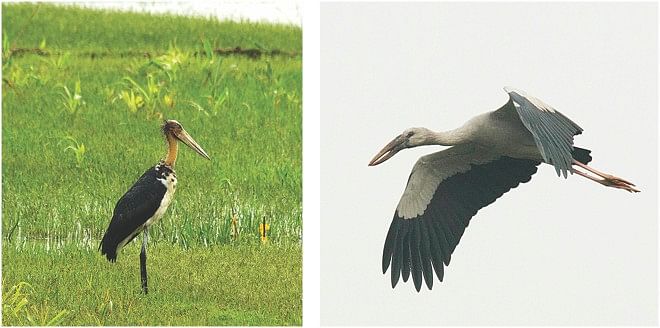Our Storks

On a wet May morning I was travelling east on a Sylhet road, past Charkhai and Barhal, heading towards Zakiganj. To my right, as far as the eye could see, fields of freshly planted rice dripped with monsoon's vibrant green. There were rice fields to my left, too, and as the eye traversed further the green ended abruptly where blue mountains rose into the sky. Those mountains of Meghalaya and Assam ring Sylhet on the north and east, eventually becoming the Tripura Hills on the south-east.
A small brickfield was coming up on the left, and when I looked beyond it, I noticed something black standing in the water-logged field behind. I stopped the car and walked across the brickfield for a clear look. To my delight it was a Lesser Adjutant Stork, known as Madantak in Bangla – the largest bird in Bangladesh and a rare one considered officially Endangered.
The Lesser Adjutant is one of two storks living in Bangladesh. The other is the Asian Openbill Stork. (Several other species of storks have shown up here as vagrants; a couple more lived here before but no more.)
Storks are members of the Ciconiidae family with twenty-six species worldwide. They are large wading birds with long legs and neck and a wide wingspan. For example, the Marabou Stork of Africa has a wingspan of ten feet, same as the Andean Condor. Storks are mute, lacking the vocal anatomy needed to sing or make calls. However, for communicating they clatter their bills and make moaning sounds.
Storks eat mostly marine animals including fish, frogs and snails. Their bills are designed to allow them to trawl through shallow water while picking up prey; their tall legs help them wade.
Because they return year after year to the same nest, storks are a good omen in many cultures. For example, in the USA, when a (human) baby is born, a stork is often shown symbolically as delivering the joyous package.
You can see Openbill Storks in many places in Bangladesh. In winter, flocks can be seen in Jahangirnagar University. The most interesting part about them is their bills. When closed, there is a small gap between them – hence the name “Openbill.” This gap is the subject of considerable scientific debate. Since the bird feeds mostly on molluscs it was thought that it uses its bill as a nutcracker, cracking open the mollusc. However, now it is known that it actually uses its lower bill to hold the mollusc in place while using the sharp end of its upper bill for severing the muscles that tie the mollusc's body to its shell.
The Lesser Adjutant is rarer. I saw one in Sundarban but it was too foggy for a clear photograph. So this was my first clear sighting. But as I got closer, it became nervous. Then it broke into a run and took flight. It flew gracefully despite its large awkward size and landed in a rice field about two hundred feet away. There it resumed its search for food at a safe distance from the human with the large black contraption in his hand.
www.facebook.com/tangents.ikabir

 For all latest news, follow The Daily Star's Google News channel.
For all latest news, follow The Daily Star's Google News channel. 



Comments